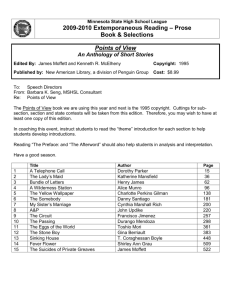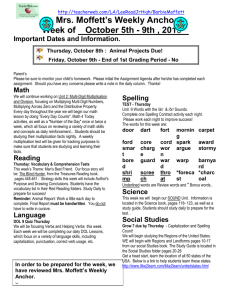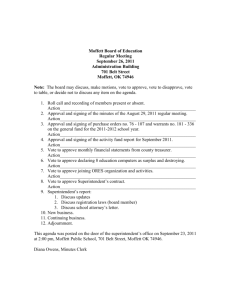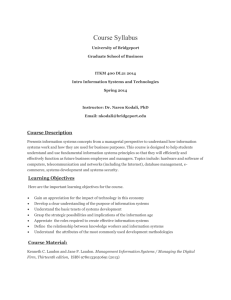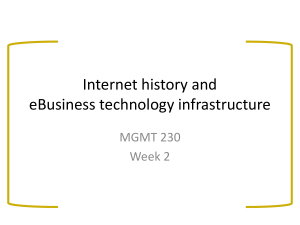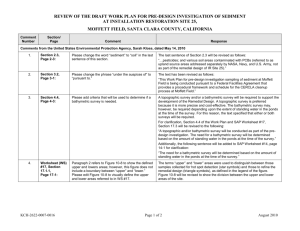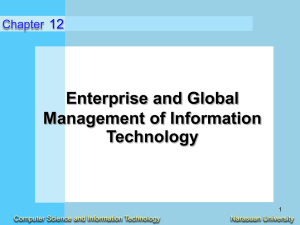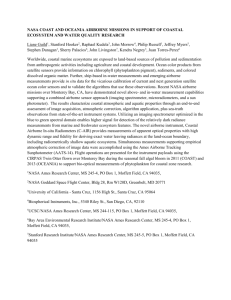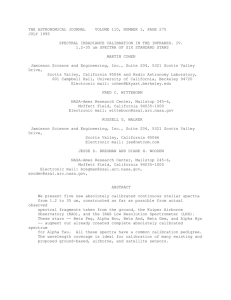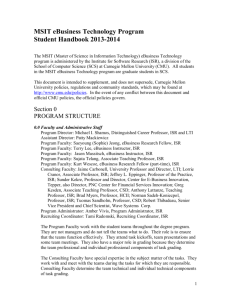Task 1 – Intro to eBusiness Technology
advertisement
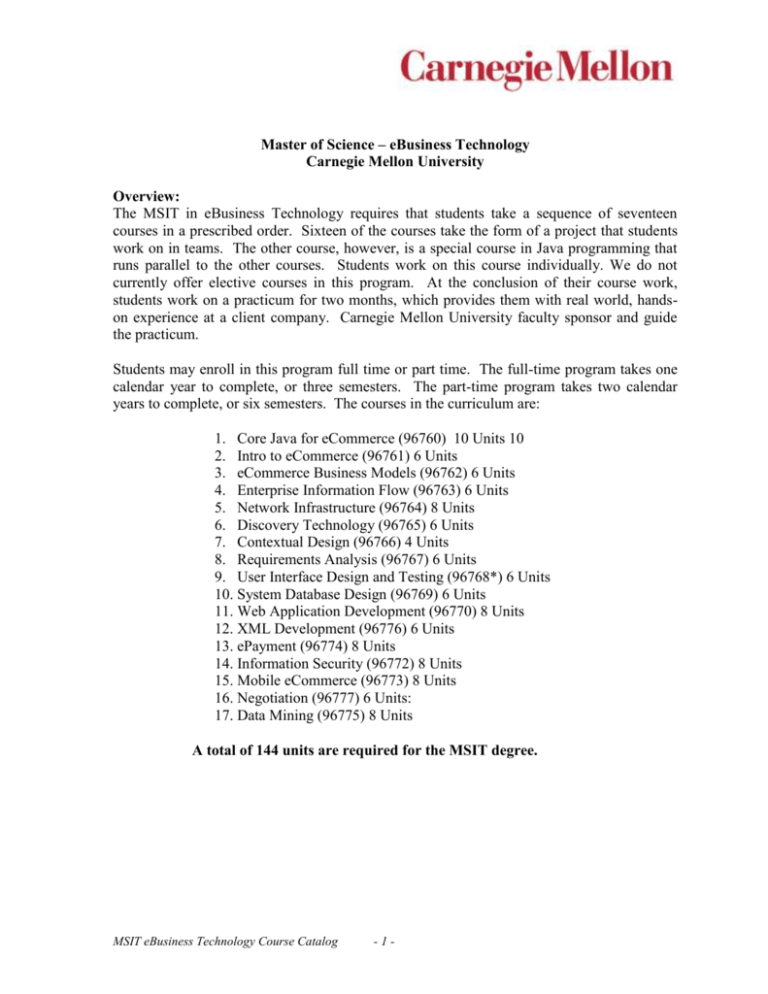
Master of Science – eBusiness Technology Carnegie Mellon University Overview: The MSIT in eBusiness Technology requires that students take a sequence of seventeen courses in a prescribed order. Sixteen of the courses take the form of a project that students work on in teams. The other course, however, is a special course in Java programming that runs parallel to the other courses. Students work on this course individually. We do not currently offer elective courses in this program. At the conclusion of their course work, students work on a practicum for two months, which provides them with real world, handson experience at a client company. Carnegie Mellon University faculty sponsor and guide the practicum. Students may enroll in this program full time or part time. The full-time program takes one calendar year to complete, or three semesters. The part-time program takes two calendar years to complete, or six semesters. The courses in the curriculum are: 1. Core Java for eCommerce (96760) 10 Units 10 2. Intro to eCommerce (96761) 6 Units 3. eCommerce Business Models (96762) 6 Units 4. Enterprise Information Flow (96763) 6 Units 5. Network Infrastructure (96764) 8 Units 6. Discovery Technology (96765) 6 Units 7. Contextual Design (96766) 4 Units 8. Requirements Analysis (96767) 6 Units 9. User Interface Design and Testing (96768*) 6 Units 10. System Database Design (96769) 6 Units 11. Web Application Development (96770) 8 Units 12. XML Development (96776) 6 Units 13. ePayment (96774) 8 Units 14. Information Security (96772) 8 Units 15. Mobile eCommerce (96773) 8 Units 16. Negotiation (96777) 6 Units: 17. Data Mining (96775) 8 Units A total of 144 units are required for the MSIT degree. MSIT eBusiness Technology Course Catalog -1- Details of the curriculum: For the duration of this curriculum, students work in teams assuming the role of an eBusiness technology task force at Moffett Foods, a fictional food manufacturing company with realworld problems. The students’ mission is to help Moffett Foods leverage eBusiness technology across their business. But there’s a long road ahead: Moffett is in the dark ages technologically, with only a simple web presence. Each of the courses in this curriculum is set in the context of helping Moffett achieve the business benefits of electronic business and, in the process, preparing students for future careers in which they will provide technical leadership and an informed strategic vision. Required Courses: Core Java for eCommerce (96760) 10 Units This is a course that students do independently, and concurrently with the main storycentered curriculum projects. It is a first programming course in support of the Masters of Science - eBusiness Technology Program. Basic familiarity with HTML is assumed as a prerequisite, but no prior programming experience is required. The course teaches core programming concepts in the context of programming Java servlets using JSP to build a website. We use Beginning JSP Web Development as our text. This book has the advantage of focusing on those aspects of Java needed for building websites, without including Java GUI programming, which is not relevant in this context. The course is organized around a single project: building a website where consumers shopping for an automobile can see what a car would cost with various options selected, and a web-based editor to allow administrators to add and modify the data on the server. Core programming concepts covered: - Data types Variables Arithmetic Strings Objects - Conditionals Loops Arrays Hashtables File I/O In addition, Java and HTML specific skills are covered, including JSP, servlets, JavaBeans, and forms. MSIT eBusiness Technology Course Catalog -2- Intro to eCommerce (96761) Units 6 Students are asked to imagine how useful it would be to track the location and status of every food product from the time it is manufactured until the time it is consumed, and to determine if this is even possible. They need to prepare a report on the potential impact of ubiquitous computing on this company within a five-year timeframe. In the report, students assess the applicable technologies, costs, and probable applications that will improve the company’s bottom line, and/or product quality, and/or customer service. In the process, they learn to do high-level business process analysis; investigate ubiquitous computing technologies and applications; consider a problem that may be on a vastly larger scale than they’ve ever considered before; and learn to think globally, as this is the crux of working within the world of eBusiness. eCommerce Business Models (96762) 6 Units Students are asked to make a recommendation to Moffett based on a thorough cost benefit analysis, of whether they should move forward with an eBusiness initiative, to build eBusiness capabilities into their existing business practices. In the process, students learn to do business process analysis at a medium level of detail; business model analyses for both the buy and sell sides of the business, as well as a market analysis, and more; determine appropriate eBusiness functionality and technologies for this particular company; and business case analysis of the potential implications of the initiative related to strategy, people, processes, finances, and other relevant areas of the business. Enterprise Information Flow (96763) 6 Units Moffett wants to improve their customer service in the sales department by making their current practices more efficient. Students analyze the “as-is” process of how information flows throughout the sales department, determining which aspects of information movement could be digitized and in what form: human-to-computer, computer-to-computer, mobile, etc. They then research technologies that could be used to change the current state to a more efficient one. Finally, students propose a “to be” process that uses new technologies to benefit the business overall. In the process, students learn to do detailed level business process analysis; focus on a specific set of sales processes, to investigate what can be automated via e-business technologies; and build skills in information strategy planning and information analysis Network Infrastructure (96764) 8 Units Moffett has decided to seek an external ASP vendor to handle its networking, and the students have to determine the best vendor for the job. Students evaluate proposals from two ASPs and select the one that best meets the company’s requirements. They then prepare report analyzing each proposal and justifying their choice of vendors. In the process, students learn to conduct detailed analyses in areas such as network performance, security infrastructure, disaster recovery, support services, etc. MSIT eBusiness Technology Course Catalog -3- Discovery Technology (96765) 6 Units In this course, students learn how web-based search engines work, and use that knowledge to very significantly increase the search-results ranking of Moffett’s web site. Moffett’s existing website is problematic because it does not appear anywhere near the top of the ranked listing in search engine results. Students are asked to experiment with the web site, learn how search engines rank pages, and used their new knowledge to make concrete operational recommendations for designing and wording the site's catalog pages to maximize search-engine visibility. In the process, students learn to use search optimization techniques and modify a baseline site to yield optimum search visibility. The techniques learned include the vector-space model for encoding web pages, query-topage similarity metrics used by search engines, other typical factors in the ranking algorithms, and how to use this knowledge effectively to change the HTML structure and content of an eBusiness web site so as to maximize probability of ranking highly for typical query sets. Contextual Design (96766) 4 Units Moffett would like to build an improved website that allows customers to get product information and make purchases from the website. Students are asked to start the design process by performing a preliminary contextual inquiry to gather the requirements of the prospective users of the website. In the process, students observe prospective users’ activities and behaviors when performing tasks on competitors’ websites in order to learn what works well and where bottlenecks occur in design. Students also develop flow, cultural, and sequence diagrams to model the output of their contextual inquiry observations Requirements Analysis (96767) 6 Units In order to begin development of an improved website for Moffett, students solicit and analyze the user and business requirements to capture what the company wants the website to support. In the process, students learn to define the scope of the site and supporting system, choosing a requirements elicitation methodology, identifying appropriate stakeholders, and constructing questionnaires. They represent the requirements using UML modeling techniques, and produce system requirements and specifications (SRS) and user requirements documentation. User Interface Design and Testing (96768*) 6 Units As the next step in producing an improved website for Moffett, students develop an HTML mock-up of the new website. They then perform a heuristic analysis on the site designs of other students teams, based on usability factors such as ease of use, look and feel, and navigation. Finally, students modify their mock-up HTML code to incorporate feedback from others on their initial design. Once each team revises their site designs following the heuristic analyses, students user-test their interfaces with prospective users and report their findings and proposed changes. MSIT eBusiness Technology Course Catalog -4- System Database Design (96769) 6 Units Continuing their effort to improve Moffett’s website, students begin their implementation work for the site by creating the database design and model, as well as class diagrams and sequence diagrams for the system. In the process students learn to design and build a logical database based on the output from their own requirements analysis (conducted in a previous required course). Web Application Development (96770) 8 Units Now that the design is complete for the improved Moffett website, students move to the heart of the website implementation, building the new site using J2EE server and relational database technologies. The implementation requires that students develop a server-side application that meets the requirements the students defined through their work in the previous required tasks. Students test the application. XML Development (96776) 6 Units Moffett would now like to provide their customers with web-enabled access to shipment tracking information for recently placed orders. This requires that the students build an application using Java, servlets, and JSP to access three different shipping vendors' XMLbased tracking services. In the course of developing this single-point, integrated shipment tracking application, students design the DTD or Schema for each vendor, as well as the XSL for presentation to the customer. ePayment (96774) 8 Units Moffett’s executives want to move to using electronic self-paying invoices (SPIs), creating electronic connections to customers, which allow just-in-time (instantaneous) payments. The team is asked to design the ePayment solution around PayPal. Students learn a great deal about ePayment processes and technologies as they produce the required deliverables, which include: a list of fields to be included in the SPI; a functional and system design of the ePayment system; a brief providing a detailed description of the technology components of the system; a design for an extension mechanism to the SPI that will enable ePayments from customers using foreign currency, resulting in final payment in US dollars; and finally, a recommendation with a justification for a suite of technologies to be used to provide security to transactions related to the SPI between the various involved entities. Information Security (96772) 8 Units Moffett is looking to implement a security policy for the network enterprise. Security is a major concern and the proper implementation from the task force (the students) is paramount. Students first learn to evaluate the potential threats to information security in the context of this business problem through defining the proper access control policy. They then build an information security plan for the enterprise, identifying the major points of concern. Finally, they implement a prototype of the system, learning how to do each part just in time, as they do their work. MSIT eBusiness Technology Course Catalog -5- Mobile eCommerce (96773) 8 Units Moffett’s sales reps have been missing important opportunities because they cannot do quick and accurate checks of product availability either while on the road or in the call center. A major initiative is planned, aimed at integrating inventory management, production planning, promotion campaign planning, and sales. The resulting system will provide real time, Available-To-Promise (ATP) functionality and order entry functionality for the sales force, to provide customers with competitive and accurate quotes, and to enable the sales force to create actual sales orders from their cellular telephones. Students in this course produce a design of a proof-of-concept prototype running on a particular cell phone, exhibiting good usability and security features; a demonstration of the prototype; and a final report reviewing alternative solution options, evaluating the potential usability, security, and costs of the cell phone solution, and making a recommendation for the best solution. Through their work, students learn to generate new business models by exploiting emerging mobile technologies; evaluate and select suitable partners in the evolving m-commerce value chain; design effective mCommerce solutions; assess evolving technologies and standards, including end-user device capabilities, architectures, usability, privacy, and security; and finally, construct a UI prototype for a mobile device that meets a particular business need. Negotiation (96777) 6 Units Moffett wants to improve its sourcing of strategic materials from its suppliers, enabling sourcing decisions to be made far more quickly, by means of electronic negotiation. They want to obtain goods at a low cost by having suppliers compete against each other in a reverse auction with expressive bidding. Students are asked to design a reverse auction-like electronic negotiation mechanism for use between this company and its suppliers. In the design report, students need to outline and evaluate the different dimensions of the design space of reverse auctions, and finally make a well-reasoned selection recommendation. They will consider dimensions such as: bidding language (which offer formats are supported), buyer's business constraints, negotiation process, pricing rules, and winner determination. Data Mining (96775) 8 Units Moffett’s marketing VPs have devised an approach to introduce selected products to each of their new customers, but in order to do it, they need to know which products are most appropriate to sell to which new customers. The CIO believes that the company's historical data can be mined for sufficiently detailed trends and associations to make these business decisions with a good measure of reliability. Then, the students are presented with a second business problem, different from the above, but also requiring data mining techniques to solve. This second problem involves predictive analysis for new-product expected sales volume prior to its introduction. Students also learn how to estimate the expected reliability of such predictions. MSIT eBusiness Technology Course Catalog -6- The students in this course are asked to use data mining techniques to comb through the historical data, and ferret out the information they are looking for based on the buying habits of existing customers and their profiles. More specifically, students learn statistical classifier data mining methods focusing on decision-tree induction and k-nearest-neighbor classifiers for multi-dimensional data in order to make predictions about new customer buying preferences and new product introduction sales volumes. Final Project: Practicum Project At the conclusion of their coursework, students engage in real-world work with a corporate sponsor as an 8-week practicum project. Students will develop a working eBusiness system prototype to address a real problem or opportunity the sponsor has identified. Sponsors submit a description of the problem and assign a contact from within the sponsoring organization to work with the student team. Teams consist of four to six students, with each student working on all aspects of the problem, including business analysis, systems requirements and design, testing, and documentation. The team is coached by a Carnegie Mellon faculty member for the duration of the project. MSIT eBusiness Technology Course Catalog -7-
